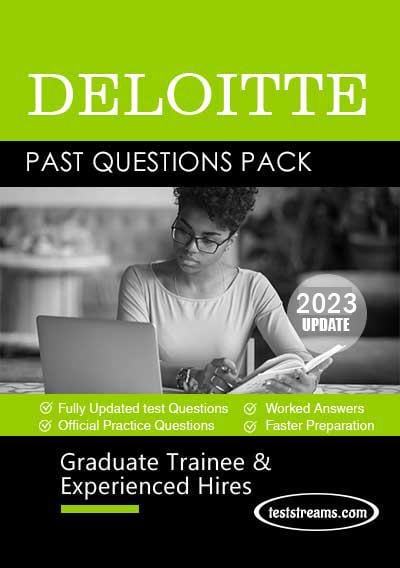Deloitte Aptitude Past Questions and Answers –[ Free PDF Download]
Landing a job at a prestigious organization like Deloitte is a dream for many aspiring professionals. With its global reputation for excellence and innovation, Deloitte is a beacon of success in the world of business and consulting. One of the initial steps in the Deloitte recruitment process is the aptitude test, a crucial assessment that evaluates candidates’ cognitive abilities, problem-solving skills, and logical reasoning.
About Deloitte
Deloitte is the global leader in professional servicesproviding audit and assurance, consulting, financial advisory, risk advisory,tax and related services. Our network of member firms in more than 150countries and territories serves four out of five Fortune Global 500®companies.We bring the innovation and IP of 300,000 professionals and our extensivealliances to uniquely provide clients the breadth of perspective needed to deliver breakthrough solutions.
The Significance of Deloitte Aptitude Tests
Deloitte employs aptitude tests as an integral part of its recruitment process to assess candidates’ readiness for the challenges that lie ahead. These tests are designed to measure various cognitive abilities, including numerical reasoning, verbal reasoning, abstract reasoning, and critical thinking. By evaluating these skills, Deloitte aims to identify candidates who possess the intellectual capacity and analytical prowess required to excel in their roles within the organization.
Why Choose Deloitte Aptitude Past Questions and Answers
- Familiarity with Test Format: Deloitte aptitude tests often follow a specific structure and format. Studying past questions and answers gives you an opportunity to familiarize yourself with the types of questions that may appear, the level of complexity, and the time constraints.
- Improved Time Management: Time is of the essence during aptitude tests. Practicing with past questions helps you develop effective time management strategies, allowing you to allocate the right amount of time to each question and section.
- Enhanced Problem-Solving Skills: Deloitte aptitude tests are designed to challenge your analytical and problem-solving abilities. By reviewing and solving past questions, you can refine your problem-solving techniques and learn to approach different question types with confidence.
- Identification of Weaknesses: Through consistent practice with past questions, you can identify your strengths and weaknesses. This self-awareness enables you to focus on improving specific areas that may need additional attention.
- Confidence Boost: Success breeds confidence. As you master past questions and answers, you’ll develop a sense of assurance in your abilities, which can have a positive impact on your overall test performance.
Preparing Effectively for Deloitte Aptitude Test
- Gather Resources: Obtain a comprehensive collection of Deloitte aptitude test past questions and answers. These resources may be available online, through test preparation books, or via career advisory services.
- Study Strategically: Allocate dedicated time for study sessions. Focus on specific question types and topics, and gradually expand your coverage as you become more proficient.
- Practice Regularly: Consistent practice is key to mastering aptitude tests. Set aside time each day to solve a set of questions, gradually increasing the complexity as you progress.
- Review and Learn: After solving past questions, review your answers, and understand the rationale behind each correct solution. Learning from mistakes is as important as getting the answers right.
- Simulate Test Conditions: Mimic real test conditions during your practice sessions. Time yourself and create a distraction-free environment to simulate the actual testing experience.
Sample Questions And Answers Of Deloitte Aptitude Test
VERBAL REASONING
Question 1:
Read the following passage and answer the question below.
“Advancements in technology have transformed the way businesses operate, leading to increased efficiency and productivity.”
What is the impact of technological advancements on businesses?
A) Reduced efficiency
B) Unchanged operations
C) Increased efficiency and productivity
D) Decreased productivity
Answer: C) Increased efficiency and productivity
Question 2:
Read the sentence and identify the synonym for the underlined word.
“Her eloquent speech captivated the audience.”
A) Boring
B) Enthusiastic
C) Persuasive
D) Simple
Answer: C) Persuasive
Question 3:
Read the following statement and answer the question below.
“Effective communication is essential for building strong interpersonal relationships.”
What is the importance of effective communication?
A) It is not necessary for building relationships.
B) It only applies to business contexts.
C) It is essential for building strong interpersonal relationships.
D) It contributes to isolation.
Answer: C) It is essential for building strong interpersonal relationships.
Question 4:
Read the passage and answer the question below.
“Team collaboration is crucial for achieving project goals and delivering high-quality results.”
Why is team collaboration important?
A) It hinders project goals.
B) It leads to low-quality results.
C) It is not essential for projects.
D) It contributes to achieving project goals and high-quality results.
Answer: D) It contributes to achieving project goals and high-quality results.
Question 5:
Read the sentence and identify the antonym for the underlined word.
“His cautious approach prevented potential risks.”
A) Careless
B) Bold
C) Confident
D) Fearless
Answer: B) Bold
Question 6:
Read the passage and answer the question below.
“Corporate social responsibility involves businesses taking actions to positively impact society and the environment.”
What does corporate social responsibility entail?
A) Ignoring societal and environmental concerns
B) Negative impact on society
C) Positive actions towards society and the environment
D) Isolation from society
Answer: C) Positive actions towards society and the environment
Question 7:
Read the following statement and answer the question below.
“Financial literacy is the ability to make informed decisions about money management.”
What does financial literacy refer to?
A) Inability to manage money
B) Lack of knowledge about money management
C) Making informed decisions about money management
D) Ignoring financial matters
Answer: C) Making informed decisions about money management
Question 8:
Read the passage and answer the question below.
“Ethical behavior in business involves conducting operations with honesty and integrity.”
What is a characteristic of ethical behavior in business?
A) Dishonesty and deception
B) Ignoring moral values
C) Acting without integrity
D) Conducting operations with honesty and integrity
Answer: D) Conducting operations with honesty and integrity
Question 9:
Read the sentence and identify the context of the underlined word.
“The CEO’s eloquent speech inspired the entire team.”
What does “eloquent” mean in this context?
A) Confusing
B) Impressive
C) Uninterested
D) Casual
Answer: B) Impressive
Question 10:
Read the passage and answer the question below.
“Globalization has led to increased cultural diversity in the workplace, which enriches problem-solving and innovation.”
What is a result of globalization in the workplace?
A) Decreased cultural diversity
B) Isolation from other cultures
C) Enriched problem-solving and innovation
D) Limited opportunities for growth
Answer: C) Enriched problem-solving and innovation
LOGICAL REASONING
Question 1:
If all bank tellers are skilled in customer service, and Jane is a bank teller, which of the following statements must be true?
A) Jane is skilled in customer service.
B) All skilled individuals are bank tellers.
C) Some bank tellers are not skilled in customer service.
D) No skilled individuals are bank tellers.
Answer: A) Jane is skilled in customer service.
Question 2:
If A is greater than B, and B is greater than C, which of the following statements is true?
A) A is the greatest.
B) B is the greatest.
C) C is the greatest.
D) A, B, and C are all the same.
Answer: A) A is the greatest.
Question 3:
If all engineers are creative thinkers, and some creative thinkers are problem solvers, which of the following statements can be deduced?
A) All engineers are problem solvers.
B) Some engineers are not creative thinkers.
C) Some problem solvers are not engineers.
D) All problem solvers are engineers.
Answer: B) Some engineers are not creative thinkers.
Question 4:
All dogs have tails. Some animals have tails. What can be inferred?
A) All animals have tails.
B) Some animals are not dogs.
C) All animals are dogs.
D) No animals have tails.
Answer: B) Some animals are not dogs.
Question 5:
If all managers are leaders and some leaders are innovative, what can be concluded?
A) All managers are innovative.
B) No managers are leaders.
C) Some leaders are not managers.
D) All leaders are managers.
Answer: C) Some leaders are not managers.
Question 6:
If all books are educational, and some books are fiction, what is true?
A) All educational books are fiction.
B) Some fiction books are not educational.
C) Some educational books are not fiction.
D) All fiction books are educational.
Answer: C) Some educational books are not fiction.
Question 7:
If no roses are yellow and some flowers are not red, which of the following must be true?
A) Some flowers are yellow.
B) No flowers are yellow.
C) All flowers are red.
D) All flowers are yellow.
Answer: A) Some flowers are yellow.
Question 8:
If no athletes are lazy and some runners are athletes, what can be inferred?
A) Some runners are lazy.
B) No runners are lazy.
C) All athletes are runners.
D) No athletes are runners.
Answer: B) No runners are lazy.
Question 9:
If all students in the class passed the exam and John is a student in the class, what is true?
A) John did not pass the exam.
B) John passed the exam.
C) Some students did not pass the exam.
D) No students passed the exam.
Answer: B) John passed the exam.
Question 10:
If no pianists are dancers and some musicians are not pianists, what must be true?
A) All dancers are musicians.
B) All musicians are dancers.
C) Some dancers are musicians.
D) No musicians are dancers.
Answer: C) Some dancers are musicians.





